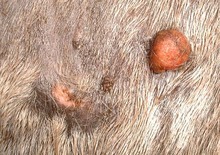During winter months, especially in cold climates, horse owners don't always give full attention to the skin health of their horses. Many horses develop heavier hair coats, and daily grooming sometimes goes by the wayside because of busy schedules and cold barns and stables.

Sarcoid on skin of horse
Horses develop tumors, nodules, and swellings on their skin in winter as well as during warmer months making it important to check your horse's skin often.
© 2018 by Malcolm Morley
Unfortunately, horses develop tumors, nodules, and swellings on their skin in winter as well as during warmer months. For this reason it is important to maintain a schedule of checking the horse thoroughly at least once a week, if not more often.
Swelling and nodules caused by insect bites or minor trauma will generally resolve rapidly without intervention. However, any new swelling that show no signs of resolving after one week of onset should be examined.
Any new mass should be brought to the attention of your veterinarian. Most new masses should be biopsied to determine what kind of tumor it is, and to plan the most appropriate treatment. The most frequently encountered external tumors of horses are sarcoids, squamous cell carcinoma, and melanomas.
Sarcoids are benign and do not metastasize, but they can be very problematic due to their locally aggressive nature. This is especially true for the eyelids and the limbs where they can cause irritation.
Squamous cell carcinomas can metastasize, but tend to do so slowly. The penis, prepuce, perineal area, eyelids, and eyeballs are the frequent sites for this tumor.
Melanomas occur most frequently around the anus of gray horses, but they are also seen around the eyelids, prepuce, udder, lips, and salivary glands. melanomas are almost always benign in gray horses, but can be aggressive and metastatic in non-gray horses. Although benign, perineal melanomas should be treated to prevent problems associated with defecation as they grow.
Diagnosis is often accomplished with a needle aspirate, but more frequently requires a biopsy. The location of the tumor and the type of tumor will dictate what treatment or combination of treatments is most appropriate.
An examination and biopsy will allow your veterinarian to determine what treatment option is appropriate for your horse’s tumor.
Nore: Updated article was first posted in 2018 on EquiMed.com
